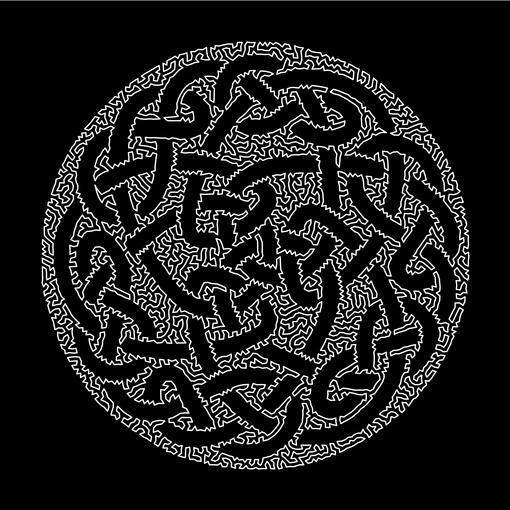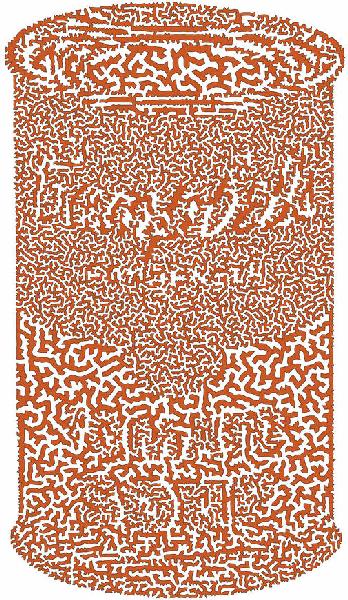Robert Bosch
"Knot?"
Digital print, 34" x 34", 2006
"Knot?" is a continuous line drawing constructed from the solution to a 5000-city instance of the Traveling Salesman Problem. From afar, the piece appears to be a picture of a celtic knot (a black cord on a white background). From up close, the piece is seen to be a simple closed curve (in white, on a black background) and therefore not a knot at all!
"What's Inside?"
Digital print on canvas, 44" by 34", 2006
"What's Inside?" is a continuous line drawing constructed from the solution to a 25000-city instance of the Traveling Salesman Problem. It is a simple closed curve drawn in black ink on a white background. From afar, it resembles one of Warhol's Soup Cans paintings. (Note: This piece is paired with the third piece.)
"This is!"
Digital print on canvas, 44" by 34", 2006
The piece "What's Inside?" is a simple closed curve. The Jordan Curve Theorem states that any simpled closed curve in the plane divides the plane into two regions: the part that lies inside the curve, and the part that lies outside. The piece "This is!" displays the interior of the "What's Inside?" curve, drawn in tomato-soup red. (Note: This piece is paired with the second piece.)
Robert Bosch
Professor of Mathematics, Robert and Eleanor Biggs Professor of Natural Science, Department of Mathematics, Oberlin College
Founder of http://www.dominoartwork.com
Statement about my art:
"I specialize in "Opt Art", the use of mathematical optimization techniques to create pictures, portraits, and sculpture. I have used integer programming to create portraits out of complete sets of dominoes. I have used linear programming to create pointillistic portraits. And I was the first to use instances of the Traveling Salesman Problem to create continuous line drawings. (Craig S. Kaplan, a collaborator who helped me improve my method considerably, submitted a stunning "TSP Art" portrait of Khachiyan last year.) What all my pieces have in common---aside from how they were constructed---is that they look very different up close than they do from afar. I create my artwork out of a love of optimization---the theory, the algorithms, its numerous applications. I believe that optimization can be applied to virtually any imaginable field, and I believe that my artwork does a good job of helping me make that point!"